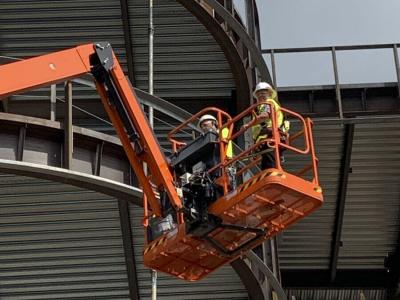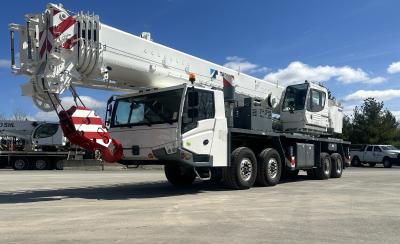Work is progressing on the multi-year and multi-million dollar project to build the Willow Island hydro-electric power plant located on the south end of the Willow Island Locks and Dam on the West Virginia side of the Ohio River.
This structure is located approximately 161.7 river mi. (260 km) below Point Bridge, Pittsburgh, Pa., and approximately 10 mi. (16 km) upstream of Marietta, Ohio. This project, when completed in the summer of 2015, will include two horizontal bulb type generating units capable of producing 37 megawatts of power with a gross head of 20 ft. It is expected to produce an average annual output of approximately 239 gWh.
The project, commissioned by American Municipal Power Inc. (AMP), will supply power to its member communities. When completed, only 10 ft. (3 m) of the approximately 114-ft. (35 m) tall reinforced concrete structure will be visible above normal river water pool. MWH Global was commissioned to provide the design for the second phase of the project.
The first phase of the two-phase project was a design-build project performed by The Ruhlin Company with its design consultants. The lead designer was Mueser Rutledge Consulting Engineers, which was done in collaboration with Geocomp Consultants Inc. and E.L. Robinson Engineering of Ohio. This included the design and then construction of a riverside and landside cofferdam, followed by the excavation of overburden to the top of rock and then the excavation of rock.
“Prior to excavation of rock, 22 high capacity rock anchors were installed to support weak seams of rock within the excavation,” said Doug Hartz, Ruhlin’s project manager. “This phase also included a dewatering system capable of pumping 3,000 gallons per-minute, an instrumentation system which included piezometers to measure ground water elevations inside the cofferdam, inclinometers to measure movement in the cellular cofferdam and rock, survey prisms and a robotic total station which measured any movements in temporary or permanent structures, tilt meters to measure movements in the dam piers, seismographs to measure vibration and finally, rock anchor strand sensors to measure load capacity in the anchors.”
The cofferdam consists of a cellular sheet pile cofferdam installed in the river and a soil bentonite cut-off wall installed on the landside of the excavation. The sheet pile cofferdam included 16 62 ft. (19 m) diameter cells filled with well-graded sand and driven to the top of rock.
“The cofferdam also included an emergency floodgate with an overflow weir in the event of a 100-year flood with a temporary bridge over the floodgate to access cofferdam cells and the dam,” said Hartz. “The landside cofferdam consisted of a three-foot wide soil bentonite slurry, which was mixed on site and installed to the top of rock with a long boom excavator. This portion of the cofferdam served as a means to control groundwater infiltration into the excavation and the stability of excavated slopes.”
The design of the first phase of the project started in November of 2010 and construction started in June of 2011. The rock excavation was completed in December of 2012.
The second phase of the project, which was designed by MWH Global, is the construction of a reinforced concrete powerhouse and its appurtenances. This includes the excavation of approach and tailrace channels with a navigational groin to divert the river through the powerhouse and a recreational area with a fishing pier located downstream of the powerhouse.
The project is presenting Ruhlin with some interesting challenges.
“The cellular cofferdam was installed with four marine crews,” he explained. “One crew worked upstream of the dam and the second worked downstream, with each utilizing a Manitowoc 888 crane on a 52 feet wide by 120 feet long crane barge. Two additional crews worked a night shift to ensure the cells were installed during favorable river conditions since high water and flow are customary on the Ohio River in the late fall and winter months. Cells were backfilled using sand delivered by barge and a Manitowoc 4100 equipped with a four cubic yard clam bucket.”
All crews were serviced with an 800 hp pushboat. Hartz added that the crews, which were supervised by General Superintendent DK Carpenter, had to coordinate large equipment with large ongoing deliveries in a small space quickly to meet the expected schedule milestones.
“Ruhlin crews have installed sheet pile cofferdams in the past,” he said, “however not this large in a short time.”
To ensure the integrity of the dam, inspections are conducted daily.
When the dam is removed (the third phase of the project) the cells will be removed using APE vibratory hammers. The cells will be re-used, according to Hartz.
Once the dam was installed, 60 ft. (18 m) of rock had to be removed to create the site to house the two Kaplan turbines. The excavation, performed by Ruhlin, was completed with Multiple Caterpillar 349 excavators and seven 35-ton (32 t) articulated trucks.
However, the rock base posed a problem.
“This was a challenge because we had to [add] some high capacity rock anchors as a result of the geotechnical conditions — the quality of the rock was less then anticipated,” said Hartz.
The powerhouse construction is proceeding on schedule.
“It’s a complicated job,” said Hartz, “but good pre-planning is helping and we are self-performing much of the work. Our benchmarks are being met.”
Several specialized subcontractors are helping out, including: Skanska for the mechanical work, and Tri-State Concrete Pumping for the 63 meter pump that is being used on site.
To coordinate the work, regular meetings are held to determine access to the site in terms of crews and equipment. The site provides sufficient space for Ruhlin and the subcontractors to establish temporary offices and parking for their vehicles, equipment and materials.
Cranes are playing a key role in the current construction and this includes two tower cranes supplied by ALL Crane in Richfuield, Ohio, and those owned by Ruhlin — a 348 Link-Belt 400-ton (362 t) crawler crane, a Manitowoc 880 230-ton (209 t) crawler crane and several hydraulic cranes — Grove RT760Es.
The Link-Belt crane will be used to lift and install the turbines, an operation scheduled for late spring.
The weather has favored the construction thus far and the only difficulties encountered are typical conditions posed by the winter, especially for the poring of concrete, according to Hartz. For this job Ruhlin is manufacturing all of its concrete on site via a portable batch plant and it is transported via its various Agitator trucks.
The design calls for concrete to be poured in at a temperature of 55F.
“This is not easy on hot summer days and our drums are insulated with spray foam,” said Hartz.
The batch plant consists of a Stevens batcher, a Secoma 1200 mixer and series of web belts and cooling equipment to chill the water and keep the aggregate cool. Aaron Rocher is serving as the batch plant superintendent. The plant is powered by a generator.
When completed, the 70,000 cu. yd. (53,519 cu m) of concrete will have been pored
Carpenter is looking after the equipment and he has two master mechanics assisting him — Tom Zudell (vehicles and equipment) and Bernie Leach (the batch plant). A repair shop has been set up, as well as supply depots for spare parts, oils and fuel.
Additional mechanics, when required, are dispatched from Ruhlin’s main shop in Sharon Center (2 and a half hours away). This also applies to additional vehicle and equipment support.
Hartz said that goodwill and dedication from the various crews and inspection personnel are keeping the work on track.
Today's top stories















